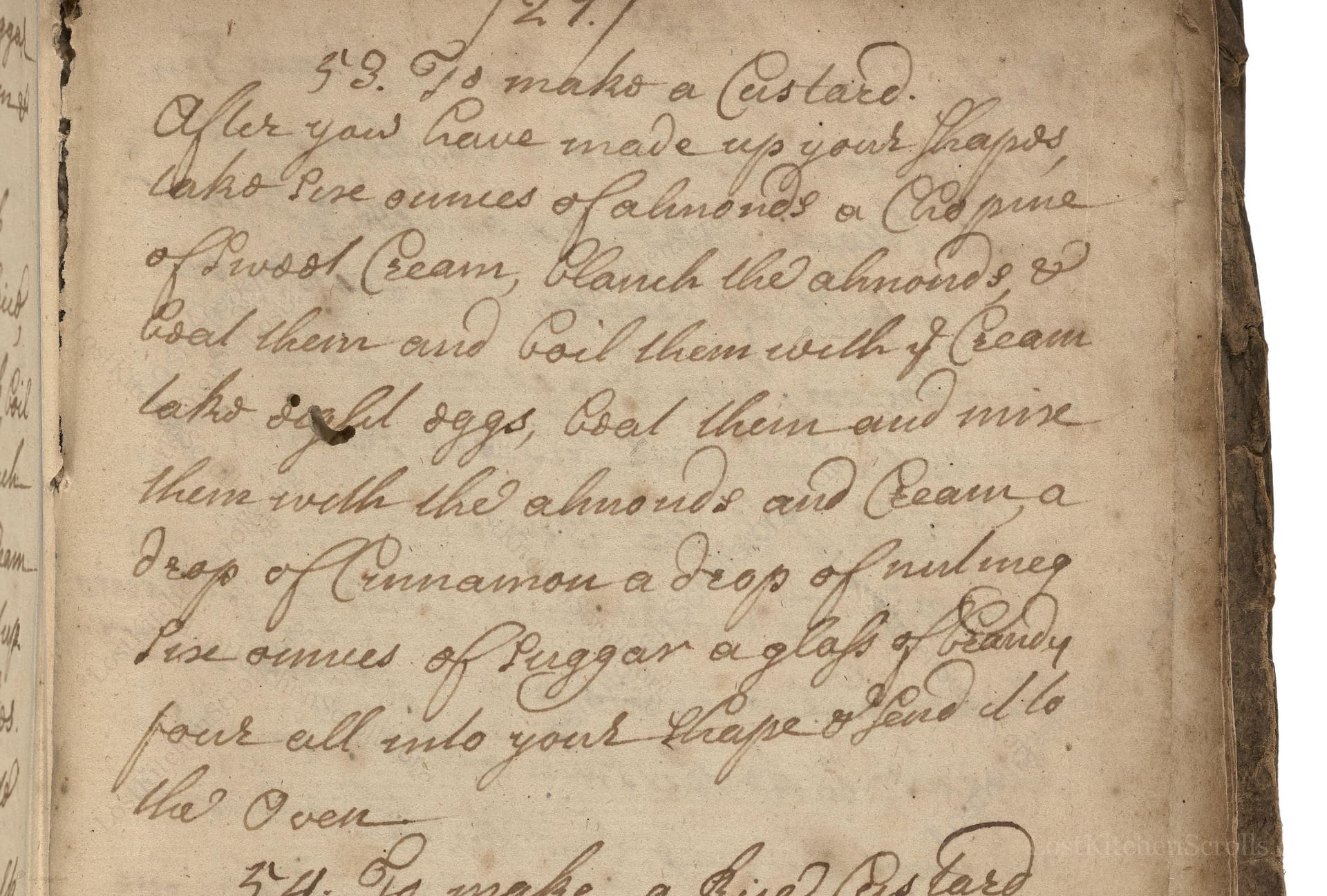To Make A Custard
From the treasured pages of Receipts for cookery and pastry work
Written by Mrs. Johnston

To Make A Custard
"After you have made up your shaps, take five ounces of Almonds a Ch pine of sweet Cream, blanch the almonds & beat them and boil them with ye Cream take six eggs, beat them and mix them with the almonds and Cream a drop of Cinnamon a drop of nutmeg five ounces of suggar a glass of Brandy pour all into your shape & send to the Oven"
Note on the Original Text
The recipe is brief and assumes prior cooking knowledge, addressing an experienced housekeeper or cook. 'Shaps' refers to 'shapes' or molds, while 'blanch' means to peel the almonds after scalding them in hot water. Spellings like 'suggar' for sugar and 'Ch pine' for 'chopine' or pint reflect variable standards in spelling and units of measure of the period. There are no precise oven temperatures or timings—cooks were expected to judge by look and feel.

Title
Receipts for cookery and pastry work (1700)
You can also click the book image above to peruse the original tome
Writer
Mrs. Johnston
Era
1700
Publisher
Unknown
Background
A delightful compilation of 18th-century recipes gathered by Mrs. Johnston herself, promising a charming journey through the flavors and culinary traditions of the early 1700s.
Kindly made available by
Folger Shakespeare Library
This custard recipe hails from early 18th-century Britain, a time when the upper classes delighted in elaborate sweet dishes flavored with exotic spices and spirits. The use of almonds and cream was a luxurious touch, signaling the wealth and refinement of the household. Sugar, spices, and imported spirits like brandy were expensive, making this a dessert for special occasions.

In the early 1700s, the cook would have used a mortar and pestle to grind the blanched almonds by hand. Cream would have been gently simmered over an open hearth, and eggs beaten vigorously with a wooden spoon or whisk. The final mixture would have been poured into a ceramic or pewter 'shape'—essentially a mold—before being baked in a wood-fired oven, perhaps inside a water bath to ensure gentle cooking.
Prep Time
15 mins
Cook Time
35 mins
Servings
6
We've done our best to adapt this historical recipe for modern kitchens, but some details may still need refinement. We warmly welcome feedback from fellow cooks and culinary historians — your insights support the entire community!
Ingredients
- 5 oz whole almonds (blanched)
- 1 cup double (heavy) cream
- 6 large eggs
- A pinch of ground cinnamon
- A pinch of ground nutmeg
- 5 oz caster sugar
- 2 tbsp brandy
Instructions
- Begin by blanching 5 oz of whole almonds and then grinding them finely with 1 cup of fresh double cream.
- Gently simmer the almond-cream mixture on low heat for several minutes, stirring occassionally to infuse flavors.
- In a separate bowl, beat 6 large eggs.
- Once the almond-cream mixture has cooled slightly, combine it with the beaten eggs.
- Add a small pinch each of ground cinnamon and nutmeg, 5 oz of caster sugar, and 2 tbsp of brandy.
- Pour this custard base into your prepared baking mold and bake in a preheated oven at 320°F until just set—about 30-40 minutes.
- Allow to cool slightly before serwing.
Estimated Calories
350 per serving
Cooking Estimates
It usually takes about 15 minutes to prepare the ingredients and the baking dish. Baking takes around 35 minutes. Each serving contains about 350 calories, and the recipe makes 6 servings.
As noted above, we have made our best effort to translate and adapt this historical recipe for modern kitchens, taking into account ingredients nowadays, cooking techniques, measurements, and so on. However, historical recipes often contain assumptions that require interpretation.
We'd love for anyone to help improve these adaptations. Community contributions are highly welcome. If you have suggestions, corrections, or cooking tips based on your experience with this recipe, please share them below.
Join the Discussion
Rate This Recipe
Dietary Preference

Den Bockfisch In Einer Fleisch Suppen Zu Kochen
This recipe hails from a German manuscript cookbook compiled in 1696, a time whe...

Die Grieß Nudlen Zumachen
This recipe comes from a rather mysterious manuscript cookbook, penned anonymous...

Ein Boudain
This recipe comes from an anonymous German-language manuscript cookbook from 169...

Ein Gesaltzen Citroni
This recipe, dating from 1696, comes from an extensive anonymous German cookbook...
Browse our complete collection of time-honored recipes



